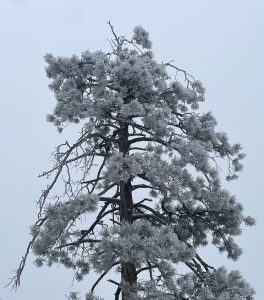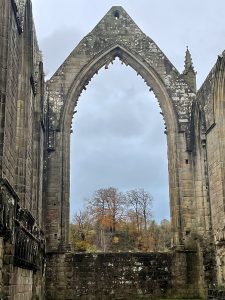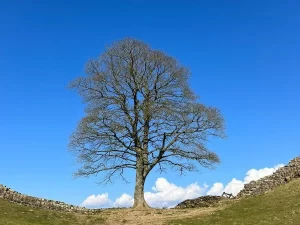My ‘lucky star’ was to be born with a solid connection to the plant world. My grandfather, a doctor and keen naturalist, had a garden covered in beech trees. Feeding the birds and squirrels was a daily routine and losing myself in the auburn woodiness of the place was emblematic of what it meant to be at granddad’s house. My father has always been an avid gardener. Most of my childhood memories are of him head down, old wooly jumper and jeans, entrenched in the large, many-roomed garden we had in the North of England. It was a place where he felt ‘at one.’ When things were good he would go to the garden and when things were more challenging he would go to the garden. So I never questioned the connection with nature. Being an only child of two elderly parents, it became my playground, my solace and my place of nurturing.
As a child, I remember, trees to me were a solid structure in which everything else fitted. Like aged grandparents, they were part of the fixtures and fittings—solid, experienced and somehow otherworldly. I played in my imaginary world in between the pillars of sustainability that the trees created. I never questioned them or even looked up to their crowns. They were merely the safe framework in which everything took place, rather like the obelisks of a Greek temple or the structure of a theatre set.
Their inconspicuousness continued. As I became an adult, trees filled that vital space that I only noticed when they were no longer there. Trees have been a part of me and yet, like in some parent-child relationships, they were maybe too powerful and necessary, too ‘given,’ for me to relate to in a more mature way.
When I trained in herbalism and botany, I built deep and intricate relationships with the plants I had loved as a child. Still, the trees remained aloof. One has to be ready for trees—like for spiritual masters and the path inward. C.G. Jung believed that we are really only able to start the journey of self-exploration and inner discovery, which he called ‘individuation,’ during the ‘second half of life.’ I am beginning to think that it is only then, that we really become ‘ready’ to connect spiritually with trees and recognize their role as teachers and guides on our quest to becoming a crone or wizard (for the lack of a better word for the masculine sage).
And so it has only been in the last ten years that my relationship with these mentors have taught me–slowly like their branches, expanding year by year. This has led me to a deeper understanding of what it is to be a tree, what it is to be me and above all what it is to belong here on this beautiful earth.
Trees have so much to teach us. Our ancestors remembered this. ‘Being like a tree’ is mentioned in the bible, “They will be like a tree planted by the water that sends out its roots by the stream. It does not fear when heat comes; its leaves are always green. It has no worries in a year of drought and never fails to bear fruit.” (1)
But what is it really to be like a tree? Trees are charged with life force. They capture and transform terrestrial energy from the earth below and cosmic forces from the sky above. They are like columns penetrating the celestial and earthly realms. They bring vitality and life down into the earth where it is anchored and available to this physical dimension. If we think of ourselves as being like trees, we can work on our alignment between our spirituality and our life here on earth.
‘We are not human beings having a spiritual experience. We are spiritual beings having a human experience.’ (2)
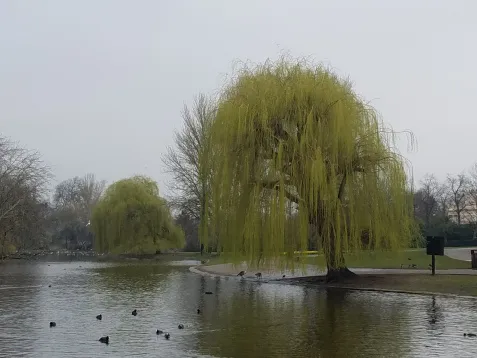
Like trees, which bring a harmonious and stabilizing energy to the planet, we occupy a place between the two worlds. These worlds meet in the area of our hearts—the doorway through which we can communicate with other humans and species.
The sky and earth analogy does not stop here, trees teach us about the two opposing parts of ourselves, light and the shadow.
“No tree, it is said, can grow to heaven unless its roots reach down to hell”. (3)
In order to be whole, it is important to recognize, accept and love all aspects of ourselves. The tree as a symbol of the Axis Mundi or ‘World Tree’ encompasses all realms of existence in the microcosm (humans) and the macrocosm (the world). Its branches reach high up into the stars and the place where Gods abide and its roots go deep into the darkness of the earth to the place where the ancestors rest. Honoring all aspects of life and ourselves is very helpful in order to step away from the continual dualities that are being played out between good and bad, science and intuitive wisdom, allopathy and alternative medicine to name but a few. It is often in the places between the extremes that a semblance of truth and balance can be found. In northern mythology, the ash tree, Yggdrasil represents the world tree and is commonly translated as ‘Odin’s horse’ drasill meaning horse and Ygg(r) being another name for Odin. Odin’s horse is the gallows from which he hung suspended upside down for nine days and nights to gain the knowledge of the world through the runes.a
“I know that I hung on a windy tree
nine long nights,
wounded with a spear, dedicated to Odin,
myself to myself,
on that tree of which no man knows
from where its roots run.” (4)
Odin’s horse could also refer to the vehicle on which Odin travels between the nine worlds in the tree’s branches and the nine worlds in its roots. What is important here is the tree’s wholeness helps us find our own, by honoring the light or what is visible and the shadow in what is underground and hidden in the dark earth we take responsibility of all aspects of ourselves. Like a fractal the tree represents us and the whole world and lives in the heart of every living thing and being.
Sacred trees are woven throughout the history of humankind. There’s the Bodhi tree (Ficus religiosa) under which Buddha was said to have gained enlightenment. There are the five sacred trees mentioned in Irish poetic writings, which include the trees of Ross, Mugna, Dathi, Usnac and Tortu (5) and my favorite, the famous Glastonbury thorn. The hawthorn known as the Glastonbury thorn was thought to have been brought to Glastonbury by Joseph of Arimathea who arrived there with the Holy Grail and thrust his staff into Wearyall hill, a long narrow ridge to the south west of the town. It was at this point that the thorn of Glastonbury grew. This legendary hawthorn tree blooms not once but twice, at Easter and Christmas and the Royal household has had a sprig of it adorning their Christmas table since the 17th century.
The stories around trees are bountiful and cross all cultures. One of the things I have noticed in my own life since trees have nudged their way into my psyche is that, wherever I go, I notice them—be it town or country—they draw my attention and teach me about the place. I no longer notice the buildings, only the trees. This gives me a sense of grounding and belonging, even in places I have never been to before. They provide a continuity in my semi-nomadic existence. I advise you to set out, if you haven’t already, on a quest to find the oldest, the biggest and the wisest trees in your area. Then visit them, spend time with them, commune with them, make wands from them, and listen to them, for they have a lot to teach us.
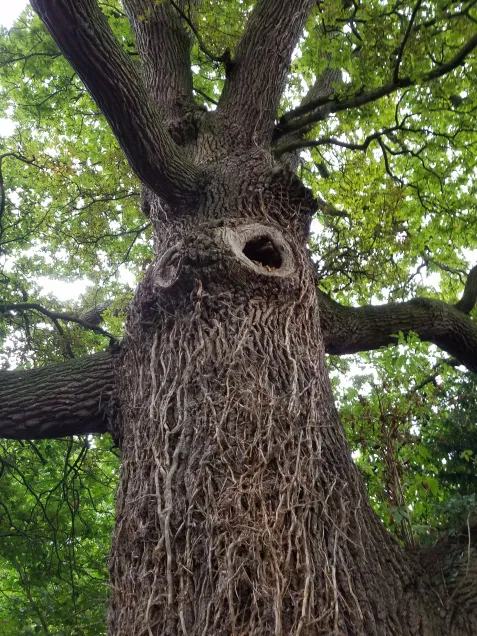
One of the ways I like to look at trees was revealed to me while researching a class I was teaching about gemmotherapy, which is making medicine from tree buds and rootlets. It was at this point in my life, spending time in early spring making medicines out of buds, that trees and I began to dance. Our brains are sealed off from the surroundings by a thick skull and ego, only receiving through filtered senses. Plant intelligence on the other hand, is situated in what are called meristem cells. These cells hold all the information needed to make any part of the tree or grow a whole new tree. They are found principally at the apical points of the tree, such as the tips of buds, shoots and rootlets, i.e. on the surface, in direct contact with the surroundings. These structures are at the origin of the way a tree constructs itself. They will become leaves, twigs, flowers, etc. They contain different zones or tiny control centers, that each have a specific function and communicate with each other. Think about this when looking at a large tree in spring. Notice the aliveness of the furthers points stretching outwards towards the sky. Underground the same thing is happening with the tips of the roots that make their way through the earth like snakes. These meristem cells contain the tree’s intelligence, i.e. they are its brain. The tree’s brain, unlike ours, is on the exterior of its being, constantly communicating with itself and its environment. It constantly adapts, depending on circumstances, climate, other trees. It is through this function that two genetically identical trees will evolve differently depending on the decisions made according to differing conditions. These cells even take into consideration neighboring plants. They communicate and making collective decisions. When I look at at tree, I remember this and then instantly see its total aliveness at every tip of every branch, bud or leaflet resulting in one huge, multi-faceted antenna constantly reacting to its environment. Taken a step further, it helps me recognize the whole, beautiful, living organism that is the forest with its fractal like consciousness creating an enormous body of plant intelligence–more than we can even imagine.
When I am walking at night and I connect with the trees, it is even easier to perceive their aliveness. They seem to have a celestial connection, as if a tiny star had settled on each tip of the tree. The Gond tribe from central Africa believe that trees are connected to earthly matters during the day and it is only at night that their real spirit emerges. They say ‘Trees contain the cosmos; when night falls, the spirits they nurture glimmer into life.’ (6)
Ancient forests and sacred groves have been used as places of worship in most cultures since time immemorial. Trees were considered the first temple of the gods. For example, the Celtic name for these tree groves was nemeton, meaning shrine or temple. (7) The root of this word nem might mean ‘to bow’, or ‘reverence’ (8). Sacred groves were seen as having a cosmological function, in contrast to the axis mundi aspect of the single tree. They often had a source or stream within them. They were thought of as representing the universe and being the home of Gods and spirits. Sometimes they are referred to as ‘Cathedral forests.’ For me, our spiritual teachers live here, in what feels like the most coherent church we could wish for. We only need to spend time in the forest to learn about each other. We can learn to live together, to accept our differences, to adapt to our environments, and to create a nourishing environment, incorporating what has passed away. We can learn cross species communication through complex invisible bonds, being part of the whole and needing the whole. We can become aware of the synergy of all life, the unavoidable and necessary seasons of life, and how diversity creates stability. The list of potential benefits is endless. Even the structure of the forest can be likened to a church. Bron Taylor looks at this architectural link in detail in his book “Encyclopedia of Religion and Nature.” The way the light comes though the forest canopy and is filtered by the leaves resembles stained glass windows of cathedrals. The solid trunks of the trees are akin to Gothic and Roman pillars. Chartres Cathedral was built in 1194 on top of an ancient Druidic sacred grove. How ironic to cut down life and put up a structure meant to echo the very organism that was destroyed. The cathedral’s ribbed vaults represented the interwoven branches of the trees and they even named the ceiling ‘the Forest’. We need to continue to honor our forests and groves rather cut them down. They are beautiful and powerful places. They contain a myriad of biodiversity. They are the best place to make offerings and perform ceremony or have celebrations. I have been lucky to have spent time in a very special sacred tree grove on friend’s land in France. This grove indeed demanded a sense of reverence when I wanted to enter, due to its sanctuary-like atmosphere, where the trees held counsel. A tragedy had beholden their family–their eldest son had been killed in an accident. After holding onto his ashes for nine years, they scattered them in their grove. It was the perfect place to hold and integrate the last material part of their son. The trees resonated with his spirit and provided a feeling of sacred home. We went on to perform tree calendar rituals and celebrations in this powerful oak grove. Luckily it should be around for generations, because the family bought the nine hectares of land surrounding their cottage to prevent intensive farming or construction. Hopefully that particular tree sanctuary is safe.
Trees are our ancestors. Not only have they inhabited the earth for millions of years before us—yes. we are the new kids on the block, but also we also share many genes with them, due to our common ancestry. I feel that now more then ever, they are calling out to us. They are telling us to wake up, see them for who they are, work with them spiritually, learn from them and, more than anything, protect them.
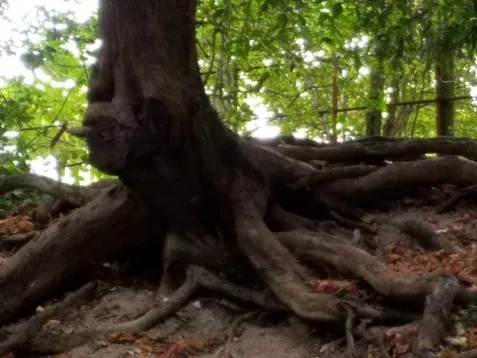
To end these rather rambling musings, I would like to share the lesson that trees are teaching me at the moment. One of the unconscious habits that I have been left with from childhood trauma is a feeling of panic that anything and everything has to be done immediately, urgently and very quickly. Its a horrible feeling as it leaves me no time to enjoy life and be in the moment. It is something I have been battling with for a long time and it’s deeply engrained. Now, thanks to the trees and their supreme knowledge of taking things slowly, a shift is happening. It began with the oak. Although now a trusted ally, it took me a long time to get to know oak. Maybe because my preconceived ideas about what I thought oak was about got in the way and maybe because oak medicine is that it does not need to rush and can and must take its time. Oak taught me a lot about ‘strength.’ It taught me that true, authentic strength is soft and loving, expansive and gentle. Oak’s energy fills space with a tender, mellow, all-expansive, very reassuring resonance. I call on oak when I need to feel safe. I ask for the presence of oak to keep things within secure boundaries. Oak is like an age-old teacher, whose mere presence is enough. Dr. Bach used oak for very strong people who fight against illness and adversity but never seem to get beyond their difficulties. This makes sense to me, because of oak’s message about what strength really is. The ‘fighter’ often has this unrealistic, unsustainable view of strength as rigidity and ‘pressure.’ Oak teaches a calm gentleness of authentic strength, coupled with a sense of timelessness. Ah yes, it is the lesson of timelessness that is helping me on my healing journey at the moment. Oaks grow slowly and surely to become a majestic keeper of the surrounding lands. One day whilst sitting with a huge, favorite oak in England–connecting as with an old friend–it gently lead me into its world, a world where it is the master of time. It took me into a place where time slows down and is no longer linear but simultaneously spans all worlds. At the same time, a sudden understanding of the tree’s incredibly high tannin content sprang into another, more analytical part of myself. I suddenly understood the link between the physical aspects of the tree and what it knows. Tannins help the tree endure the tests of time on a physical level. Oaks have incredible longevity. Few other trees can equal it or surpass it. Their wood is also incredibly hard, heavy and strong, due to the tannins. The etymology of the word ‘tannin’ even comes from the Latin word ‘tannun’ meaning ‘oak bark’. ‘The teacher appears when the student is ready’ and so it did! Now, every day, I feel the calm slowness of taking my time as it replaces the traumatized panic that dominated my life. I thank oak for teaching me that which it masters so well both on a physical and spiritual level.
“Listening to oneself beyond the boundaries of what we call reality. Inner listening aligned with one’s true self, the natural one who is part of all and where all resides. Trees are our masters, don’t look any further you have found the guides you have been looking for all your life. They do not come in human form but are all embracing shadows of the truth. They will lead you at all times to your inner being, they will shine the light so that you see more clearly – they are part of you, yes, hazelnut, ash, oak, beech, pine, birch, hawthorn they are all part of you and they come from where you come from.”
Interested in deepening your relationship with nature? Sign up for the 200 hour online class on Intuitive Plant Communication.
References
1) Jeremiah 17:8, New International Version
2) Teilhard de Chardin, “The Phenomenon of Man”
3) Carl Jung, “Aion: Researches into the Phenomenology of the Self”, chapter 5
4) Stanza 137 of the ‘Hávamál.’ https://en.wikipedia.org/wiki/H%C3%A1vam%C3%A1l
6)Bhajju Shyam, Durga Bai, Ram Singh Urveti “The nightlife of trees”, Tara publishing
7) https://en.wikipedia.org/wiki/Nemeton
8) Carol M Cusak, “The Sacred Tree: Ancient and Medieval Manifestations”
9) Cathy Skipper, ‘Listening to Trees’, Plant Communication Online Class https://courses.aromaticstudies.com/product/plant-communication-with-cathy-skipper/
share this blog:
Recent Posts
Archives
- December 2023
- November 2023
- September 2022
- July 2022
- September 2021
- August 2021
- July 2021
- June 2021
- April 2021
- March 2021
- February 2021
- January 2021
- November 2020
- October 2020
- August 2020
- July 2020
- June 2020
- May 2020
- April 2020
- March 2020
- February 2020
- October 2019
- September 2019
- July 2019
- May 2019
- March 2019
- September 2018

